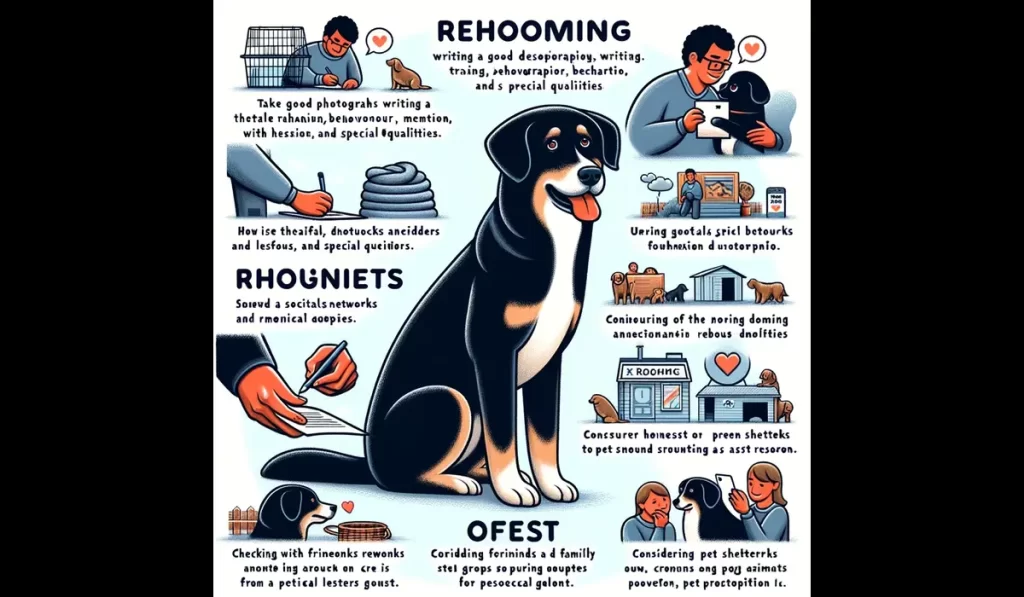Here’s a breakdown on how to responsibly rehome your dog, including considerations and the emotional impact:
Reasons for Rehoming
- Life changes: Job loss, moving, health issues
- Pet needs: Behavioral problems, allergies, expenses
- It’s important to explore all options first before choosing to rehome.
Finding the Right New Home
-
Prepare Your Dog: Ensure they’re well-groomed, up-to-date on vaccinations, and preferably spayed/neutered.
-
Write a Compelling Ad: Include photos, personality description, medical history, and your dog’s unique qualities. Be honest about any needs or challenges.
-
Leverage Your Network: Spread the word through friends, family, workplaces, vet clinics, and local pet communities.
-
Online Resources:
- Animal rescues and shelter websites
- Social media platforms, including breed-specific groups.
-
Interview and Home Visit: Thoroughly check a potential adopter’s suitability, experience, home environment, and commitment to care.
Surrendering to a Shelter
- A last resort if you cannot find a home yourself.
- Be aware of the shelter’s intake and adoption policies.
- Understand that “no-kill” policies vary, and euthanasia might still occur due to limited resources, health, or aggression issues.
Will Your Dog Miss You?
- Yes. Dogs form deep bonds, and separation causes grief.
- Signs of grief: Changes in appetite, behavior, energy levels, and clinginess.
- With patience and love, your dog will heal and bond with the new owner.
Key Takeaways
- Rehoming is a serious decision with emotional impact on both you and your dog.
- Prioritize finding a loving home where your dog will thrive.
- Be honest and transparent with potential adopters.
- If surrendering to a shelter, understand their policies and limitations.
How to Rehome a Dog?- How to Get Started with Rehoming Your Dog?
While advertising for new owners, you must put your pet’s best foot forward.
- Take a good color picture of your pet in its ‘element.’ You can take a picture you already have and make it available for use.
- Prepare a brief description/biography for your dog. This should include any training that your dog has had. Also, mention how your dog gets along with other animals, children, strangers, etc. You must list out their medical history and any medication they may be taking. Also, mention their favorite treats and their most miniature favorite food. Most importantly, what makes your dog special.
- Be honest about your pet when you look for someone to adopt it. Full disclosure will help in finding the best home for your pet. If your pet requires medication or any other kind of special care, be sure to say so
- Make sure your pet is well-groomed and up-to-date on her vaccinations. Also, ensure that your precious pup is free from fleas and ticks.
- If you haven’t already, make sure your pet is spayed or neutered. Look for low-cost but standardized spay/ neuter clinics in your area.
Check with Friends and Family
First, check with your immediate circle of people if anybody wants a dog. With trusted family members, friends, co-workers, etc., you have better chances of finding a loving home for your pet. Speak to other pet owners, people from your pet’s veterinary clinic, people from your pet store, etc.
Most nonprofit and humane societies and animal rescues accept courtesy listings for their websites.
Social networking sites can help you find people who might be interested in your pet. Breed-specific Facebook pages can also help with the rehoming process.
When a prospective adopter gets in touch with you, interview the individual and conduct a home visit to ensure your pet’s owners-to-be are people who will take care of your pet well.
While interviewing, it’s essential to check the following details about prospective pet owners.
- Whether the person has previous experience caring for pets?
- Check whether their home is big enough to accommodate your pet
- Check if they have the financial means to care for your dog
- Most importantly, check if they have realistic expectations of living with your pet.
Surrendering Your Dog to a Pet Shelter
Suppose, despite your best efforts, you are unable to find a suitable home for your pet on your own. In that case, it is advisable to surrender your pet to an animal rescue or municipal animal shelter. Many adoption contracts specify that you return the pet to them rather than rehome it on your own.
Every organization you approach makes sure that you review their surrender and adoption policies before giving up your pet. Find out what organizations they partner with which may increase the adoption potential of animals in their care.
The Horrible Myth of ‘No Kill’ Shelters
Most animal shelters take in all the animals that come to them. However, when they run out of space or funding, they euthanize animals to make room for new ones. It is the same case with aggressive animals that cannot be quickly adopted.
Many animal welfare professionals are working to ensure that no innocent animal gets killed. These actions are usually done if the shelter has more animals in its care than what is considered safe and legal.
Shelters are also prohibited from adopting aggressive animals. Even genuinely no-kill shelters can euthanize when animals are deemed unadoptable due to some illness or history of aggression.
Will Your Dog Miss You?
For you, your pet dog might have just been a part of your life. However, for your dog, you are everything. It is normal and natural for dogs to grieve the absence of a person they have bonded with when they are no longer present.
Your dog might not understand the full extent of the human absence. However, your dog will understand the emotion of missing someone who is no longer a part of their daily life.
Signs Your Dog is Grieving
No two dogs are alike in the way they grieve. In order to accurately decipher your dog’s emotional state, you should look for some tell-tale signs. Your dog’s sadness can be expressed through behavioral changes. Your dog will express anxiety and stress through the following gestures.
- Panting
- Whining
- Barking
- Pacing
- Fidgeting
- Loss of appetite
- Weight loss
- Lack of energy
- Clingyness
- Lack of interest in physical activity
Experts say that it is best to let a dog figure out its feelings of missing or grief on its own. However, you can help out by being sensitive to your dog’s needs during this time.
- Be completely aware of routines and ensure that you stick to them
- Comfort your new pet by spending more time together
- Show extra affection. It is proven that touch increases bonding
- Play their favorite game and increases physical activity.
Irrespective of how loving and caring you are, your dog may still take its time to grieve its separation from its previous owner. This could be especially true when the dog shares a special bond with the previous owner. Just like us humans, even dogs need their time to heal from a profound emotional loss.
What could be reassuring to you is that just like human beings, your dog, if adequately cared for, will soon figure its way out of its grief and open up its heart to accept love again. With time your dog will form a bond with its existing owner like its previous one, provided the owner is loving and caring.
When you first got a dog, you most probably did so with the idea of a life-long relationship. However, sometimes things don’t go as planned.
Maybe your partner is allergic to dogs, and your work demands that you travel a lot, your dog has developed behavioral or medical problems. Irrespective of the reason, the responsible alternative to taking care of your dog yourself is rehoming it.
Generally, it is better that you exhaust all other options before you resort to rehoming your dog in any situation. The bond you share with your pet is unique, and separation may mean some amount of stress and anxiety for both of you.
- If your financial state is bothering you, you could ask friends or family to help out till your current situation changes.
- Medical problems can also be quite overwhelming. But there might still be some way by which you could still keep your dog and get support while caring for it.
- If it’s a behavioral problem, the good news is that it can be solved or significantly reduced through training, conditioning, and behavior modification.
Remember, if you want to keep your dog, you will find a solution. If not, you will find excuses. Be aware of what you will be putting your dog through by leaving it in the care of someone else. Think about how your pet will process the grief of being separated from you.
If at all you still have to give your dog away, make sure you find a suitable new owner.








